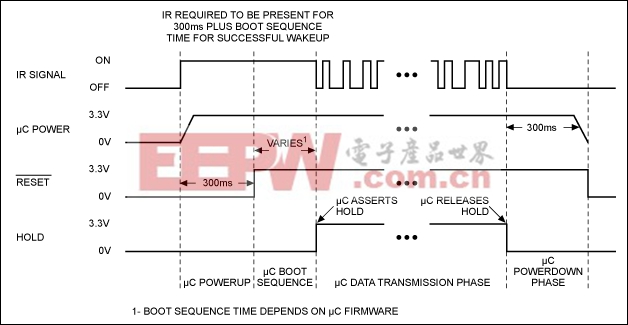Wake up and hear the IR
时间:08-12
来源:互联网
点击:
Receiving infrared (IR) signals while conserving system power is difficult, and typically requires the inclusion of complex power-management routines in the firmware. You can avoid that problem by disconnecting power to the microcontroller when IR is not present. The resulting circuit draws less than 2µA of supply current while in standby mode, and approximately 40µA when active.
-- ======================================================================= -->-- CONTENT: DB HTML -->-- ======================================================================= -->A similar version of this article appeared online in the October 10, 2006 issue of EE Times.
Receiving infrared (IR) signals while conserving system power is difficult, and typically requires the inclusion of complex power-management routines in the firmware. You can avoid that problem by disconnecting power to the microcontroller when IR is not present (Figure 1). U1 holds the attached microcontroller in an ultra-low power-down state until the phototransistor (Q1) detects an IR signal.

Figure 1. This circuit withholds power from the attached microcontroller until it detects an IR transmission. While in standby mode, its quiescent current is less than 2µA.
Upon detecting an IR signal and after a suitable delay (300ms in this case), the circuit connects power to the microcontroller and applies a reset signal to it (Figure 2). After power-up, the microcontroller must assert its Hold line to prevent the circuit from returning to standby mode when the IR transmission ends. U2 buffers and inverts the IR transmissions. When the microcontroller has completed its tasks and no more IR transmissions are present, it returns the circuit to standby mode by deasserting the Hold line.

Figure 2. When the Figure 1 circuit detects an IR signal, it powers and resets the microcontroller. After the IR transmission ends, the microcontroller suspends itself by releasing the Hold line.
The circuit draws less than 2µA of supply current while in standby mode, and approximately 40µA when active. The combined battery monitor and microprocessor supervisor (MAX6848K) comes in several versions, offering multiple voltage thresholds for the microcontroller power, and multiple RESET delays. Thus, you should choose the part-number option according to your application. The maximum data rate (determined by Q1) exceeds 10kbps.
-- ======================================================================= -->-- CONTENT: DB HTML -->-- ======================================================================= -->A similar version of this article appeared online in the October 10, 2006 issue of EE Times.
Receiving infrared (IR) signals while conserving system power is difficult, and typically requires the inclusion of complex power-management routines in the firmware. You can avoid that problem by disconnecting power to the microcontroller when IR is not present (Figure 1). U1 holds the attached microcontroller in an ultra-low power-down state until the phototransistor (Q1) detects an IR signal.

Figure 1. This circuit withholds power from the attached microcontroller until it detects an IR transmission. While in standby mode, its quiescent current is less than 2µA.
Upon detecting an IR signal and after a suitable delay (300ms in this case), the circuit connects power to the microcontroller and applies a reset signal to it (Figure 2). After power-up, the microcontroller must assert its Hold line to prevent the circuit from returning to standby mode when the IR transmission ends. U2 buffers and inverts the IR transmissions. When the microcontroller has completed its tasks and no more IR transmissions are present, it returns the circuit to standby mode by deasserting the Hold line.

Figure 2. When the Figure 1 circuit detects an IR signal, it powers and resets the microcontroller. After the IR transmission ends, the microcontroller suspends itself by releasing the Hold line.
The circuit draws less than 2µA of supply current while in standby mode, and approximately 40µA when active. The combined battery monitor and microprocessor supervisor (MAX6848K) comes in several versions, offering multiple voltage thresholds for the microcontroller power, and multiple RESET delays. Thus, you should choose the part-number option according to your application. The maximum data rate (determined by Q1) exceeds 10kbps.
- 电路板的焊盘设计(05-23)
- NAND Flash SLC MLC技术分析(08-22)
- CMOS 图像传感器主导多种应用,提供巨大市场机遇(10-18)
- 台湾茂丞科技(J-Metrics)主动式垂直射频技术指纹传感器解析(08-15)
- 音频放大器类别(09-11)
- 基于压力传感触控技术的室内定位地板(10-29)
